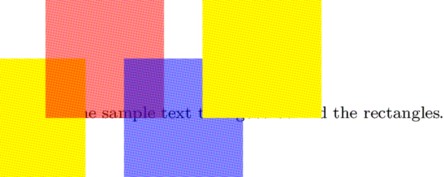Transparency
Defining transparent colors
You can define transparent colors through setting t, e.g. t=0.5. Beware, some PDF viewers and printshops can't handle PDF transparences!
Hans Hagen posted the following sample code for transparent colors on the mailing list on 2005-07-13; the yellow blocks have been added to demonstrate the order in which the blocks are drawn on the page; the first yellow block is behind the transparent red and blue blocks, while the second is in front of them.
\definecolor [transparentred] [r=1,t=.5,a=1] \definecolor [transparentblue] [b=1,t=.5,a=1] \definecolor [solidyellow] [y=1,t=1,a=1] \starttext \startTEXpage This is some sample text that goes behind the rectangles\hskip-8cm \blackrule[width=2cm,height=1cm,depth=1cm,color=solidyellow]\hskip-0.67cm \blackrule[width=2cm,height=2cm,color=transparentred]\hskip-0.67cm \blackrule[width=2cm,height=1cm,depth=1cm,color=transparentblue]\hskip-0.67cm \blackrule[width=2cm,height=2cm,color=solidyellow]\hskip2cm. \stopTEXpage \stoptext |

|
Rendering
Acrobat Reader might not render transparency using RGB in a PDF that is displayed on a monitor. If the colours do not appear correctly, add the following code:
\setupcolors[pagecolormodel=auto]
In Acrobat, when transparency is used, a different route is followed (at least in the past) when rendering. Rendering colorspaces might be adapted to the output medium so it's a combination of colorspace, monitor/paper, calibration, knockout/overprint, transparency groups, assumptions, and so forth.